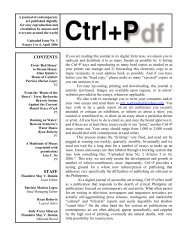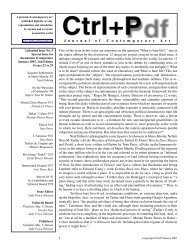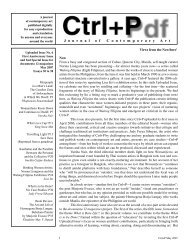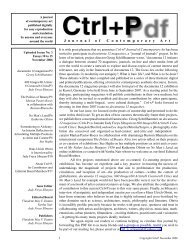Issue 15 - Pdf Ctrl+P - CTRL+P: a journal of contemporary art
Issue 15 - Pdf Ctrl+P - CTRL+P: a journal of contemporary art
Issue 15 - Pdf Ctrl+P - CTRL+P: a journal of contemporary art
You also want an ePaper? Increase the reach of your titles
YUMPU automatically turns print PDFs into web optimized ePapers that Google loves.
Victorio Edades. The Builders.<br />
Image courtesy <strong>of</strong> the Cultural Center<br />
<strong>of</strong> the Philippines.<br />
Collecting History<br />
There is no existing history <strong>of</strong> the <strong>art</strong> collection. This commemorative exhibition<br />
seeks to reconstruct how objects made their way into the institution as an initial survey<br />
<strong>of</strong> sightlines. We can point to specific sources:<br />
First the building itself, which opened in 1969, that housed donations from such<br />
<strong>art</strong>ists as Hernando R. Ocampo, who <strong>of</strong>fered his design for the work Genesis that was<br />
transformed into a wondrous tapestry by Japanese weavers to serve as the iconic curtain<br />
<strong>of</strong> the Main Theater; Arturo Luz (Black and White) and Cesar Legaspi (Triptych) likewise<br />
donated murals, which adorn the Little Theater Lobby, alongside Eduardo Castrillo’s<br />
metal totem Pyramid Growth. Other works, most probably commissions as well,<br />
that were built into the structure include Vicente Manansala’s brass relief Tribute to the<br />
Seven Arts for the Main Theater entrance and Roberto Chabet’s collage for the curtain<br />
<strong>of</strong> the Little Theater. A panel <strong>of</strong> Carlos Francisco’s Abuses <strong>of</strong> Spanish Authorities for the<br />
New York World’s Fair in 1964; Napoleon Abueva’s Ballet Dancer; and Arturo Luz’s<br />
gargantuan paper clip were later additions to the public <strong>art</strong> collection <strong>of</strong> the Center. 6 By<br />
presidential fiat in 1966, the site <strong>of</strong> the building was decreed, and thereafter the Board <strong>of</strong><br />
Trustees was named. The edifice, sitting on 21 hectares <strong>of</strong> reclaimed land from Manila<br />
Bay, is by itself p<strong>art</strong> <strong>of</strong> the <strong>art</strong> collection in a manner <strong>of</strong> speaking. Designed by Leandro<br />
Locsin, it speaks <strong>of</strong> the style that was hailed then as innovative and its engineering, a<br />
public works feat for a Third World country in Southeast Asia: cantilevered construction<br />
in raw concrete with the use <strong>of</strong> crushed shells on site as aggregate and landscaping by<br />
Ildefonso P. Santos.<br />
The commitment <strong>of</strong> the architect to the visual <strong>art</strong>s was earnest as indicated in the<br />
blueprint: a painting and sculpture hall with a section on <strong>contemporary</strong> <strong>art</strong>; a colonial<br />
<strong>art</strong> pavilion, split into two levels in which the San Jose church baroque altar donated<br />
by Antonio Bantug was to be ensconced; the Arturo de Santos collection <strong>of</strong> <strong>art</strong>, gold,<br />
and ceramics; the Potenciano Badillo collection <strong>of</strong> Muslim <strong>art</strong>; and a library for <strong>art</strong> and<br />
music. These pavilions would be surrounded by gardens, fountains, pools, and plazas so<br />
that visitors may be “surprised at every turn as new vistas unfold.” 7<br />
Second, the initial acquisitions, largely undertaken by Roberto Chabet, who was<br />
appointed Curator as early as 1967, two years before the Center formally opened to the<br />
public. He purchased for the Center important pieces like Victorio Edades’s The Builders<br />
and Napoleon Abueva’s Allegorical Harpoon. 8 It could be that some <strong>of</strong> these early pieces<br />
were p<strong>art</strong> <strong>of</strong> Summer Exhibition 1970,<br />
described as a “serendipitous collection<br />
<strong>of</strong> over 100 paintings, sculptures, prints,<br />
drawings, and ‘but-is-it-<strong>art</strong>?’ objects that<br />
virtually span six decades <strong>of</strong> Philippine<br />
<strong>art</strong> history.” 9 It is reported that works<br />
like The Builders, Fernando Amorsolo’s<br />
Burning <strong>of</strong> Manila, Ofelia Gelvezon’s<br />
pinball series, and Brenda Fajardo’s<br />
“classic-inspired etchings” were p<strong>art</strong><br />
<strong>of</strong> this ensemble; and indeed they are<br />
in the collection. To prepare Chabet for<br />
his duties, the CCP secured for him a generous grant from the John D. Rockefeller Fund<br />
so that he could observe museum procedures, administration, and related techniques in<br />
the United States, from 1967 to 1969. Chabet, who was trained as an architect at the<br />
University <strong>of</strong> Santo Tomas and was cited by Galo Ocampo 10 as Chabet Rodriguez in an<br />
essay on Philippine <strong>art</strong> history as early as 1963, had no background as a curator or as<br />
an <strong>art</strong> historian and came into the scene with his modest reputation as an <strong>art</strong>ist whom<br />
Arturo Luz deemed worthy to be exhibited in his eponymous gallery; he won First Prize<br />
at the Art Association <strong>of</strong> the Philippines annual competition in 1961. The registry <strong>of</strong> the<br />
collection lists Lee Aguinaldo’s Linear #24 (acrylic on wood) as one <strong>of</strong> the first to be<br />
bought before CCP’s inauguration; and Leonard Aguinaldo’s E-Maginings as one <strong>of</strong> the<br />
latest purchased in 2008.<br />
34 <strong>Ctrl+P</strong> September 2009







